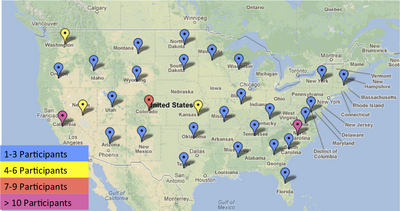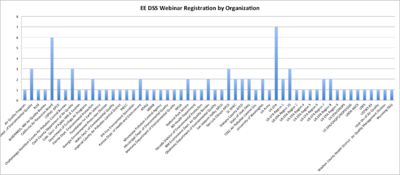Difference between revisions of "EE DSS Webinar"
| (30 intermediate revisions by 3 users not shown) | |||
| Line 1: | Line 1: | ||
<noinclude>{{Exceptional Air Pollution Event Analysis Community Workspace Backlinks}}</noinclude> | <noinclude>{{Exceptional Air Pollution Event Analysis Community Workspace Backlinks}}</noinclude> | ||
| − | This | + | This series of two webinars will introduce the Exceptional Event Decision Support System (EE DSS) of which purpose is to identify and to document observations that are candidates for exceptional event flagging. The first session will be focused on screening the AQS data for exceedances above "normal" values and to indicate potential smoke or dust causes. The webinars and the '''[[Exceptional_Air_Pollution_Event_Analysis_Community_Workspace|associated wiki workspace]]''' are provided to give States and EPA Regions the opportunity to ask questions and provide feedback on how to improve the EE DSS. A second webinar is planned for the end of May on the same topics, incorporating feedback from State analysts and pursuing further flagging use cases. |
| − | + | The '''main output''' of this decision support effort will be a national-scale list of candidate samples (these are not "official") for EE flagging for 2010-2012. Based on this screening, States can identify and select candidate samples for EE flagging, to be submitted to EPA by the July 1, 2013 deadline. The anticipated '''outcomes''' and benefits of the EE Decision Support will include: reduction of the effort required by the States for EE flagging as well as a simpler and more uniform EE flag evaluation process by the EPA Regions. | |
| − | + | ||
| − | + | __TOC__ | |
| − | + | = Webinar #3 EPA EE Workgroup = | |
| − | + | ||
| + | |||
| + | = Webinar #2 Outline= | ||
| + | This webinar is a continuation of the EE DSS topics, with deeper explanation of the EE tools, feedback from State analysts and illustration of further flagging use cases. Registration details are below. | ||
| − | + | == Registration Details== | |
| + | Topic: Exceptional Event DSS Training <br> | ||
| + | Date: Thursday, May 30, 2013 <br> | ||
| + | Time: 3:00 pm, Eastern Daylight Time (New York, GMT-04:00) <br> | ||
| + | Session Number: 925 803 111 <br> | ||
| + | ------------------------------------------------------- | ||
| + | To register for this training session | ||
| + | ------------------------------------------------------- | ||
| + | Go to https://esipfed.webex.com/esipfed/k2/j.php?ED=225947427&UID=0&HMAC=802698d3f6962a53058c4ddded64382c812f755c&RT=MiMxMQ%3D%3D and register. | ||
| − | + | =Webinar #1 Outline = | |
| + | During the first 90-minute webinar we will cover the following topics: | ||
| + | * The approach of EE DSS to address the clauses required by the Exceptional Event Rule; | ||
| + | * Datasets (FRM, satellite, model) and tools used in the EE DSS | ||
| + | * Analysis approach: finding exceedances and those above normal variations; | ||
| + | * Suggested exceptional (dust or smoke) sources for candidate samples | ||
| + | * Demonstration of specific flagging examples | ||
| + | [https://esipfed.webex.com/esipfed/lsr.php?AT=pb&SP=TC&rID=67091752&act=pb&rKey=8fc3b7a14ac43371 Webinar Recording] | ||
| + | == Neil Frank: Introduction, Background (5 min) == | ||
| + | == Bob Lebens, State/Region Rep (5 min) == | ||
| + | == Rudy Husar: EE DSS Approach and Demo (45 mins)== | ||
| + | <html><iframe src="http://www.slideshare.net/slideshow/embed_code/20341462?rel=0" width="427" height="356" frameborder="0" marginwidth="0" marginheight="0" scrolling="no" style="border:1px solid #CCC;border-width:1px 1px 0;margin-bottom:5px" allowfullscreen webkitallowfullscreen mozallowfullscreen> </iframe> <div style="margin-bottom:5px"> <strong> <a href="http://www.slideshare.net/rhusar/20130430-ee-dss-approach-and-demo" title="2013-04-30 EE DSS Approach and Demo" target="_blank">2013-04-30 EE DSS Approach and Demo</a> </strong> from <strong><a href="http://www.slideshare.net/rhusar" target="_blank">Rudolf Husar</a></strong> </div></html> | ||
| + | * Screening Tool - Introduce screening procedure: Exceedances... , Excess to Normal, Some context finding exceedances and those above normal variations; Showing the screening tool: PM2.5, Ozone and PM10 | ||
| + | ** How-to cases (NM, ... ) | ||
| + | *** Spatial Context | ||
| + | *** Temporal Context | ||
| + | *** Statistical Context | ||
| + | * Data and Tools to be used in Description/Documentation of Flagged Samples | ||
| + | ** Suggested exceptional (dust or smoke) sources for candidate samples | ||
| + | ** Datasets (FRM, satellite, model) and tools used in the EE DSS, link to console | ||
| + | ** Consoles | ||
| + | ** CATT - Transport Tool | ||
| + | * [[2013-04-30_EE_DSS_Webinar_Demo| Demo of EE DSS Tools]] | ||
| − | + | == Erin Robinson - Introduction to EE Analyst Community (5 mins) == | |
| − | === | + | <html><iframe src="http://www.slideshare.net/slideshow/embed_code/20345973" width="427" height="356" frameborder="0" marginwidth="0" marginheight="0" scrolling="no" style="border:1px solid #CCC;border-width:1px 1px 0;margin-bottom:5px" allowfullscreen webkitallowfullscreen mozallowfullscreen> </iframe> <div style="margin-bottom:5px"> <strong> <a href="http://www.slideshare.net/erinmr/130430-webinar-erobinson" title="Introduction to Exceptional Event Analyst Community" target="_blank">Introduction to Exceptional Event Analyst Community</a> </strong> from <strong><a href="http://www.slideshare.net/erinmr" target="_blank">Erin Robinson</a></strong> </div></html> |
| − | |||
| − | ==== | ||
| − | |||
| − | |||
| − | |||
| − | |||
| − | |||
| − | |||
| − | |||
| − | + | * Adding links to EE-relevant resources | |
| − | + | * Explain how to give feedback on screener tool; Feedback on Data; Workspace/community interaction ideas. | |
| − | + | ** Wiki discussion pages | |
| − | + | ** Email and permission to transfer | |
| − | + | ** Weekly drop-in calls for questions/comments? | |
| + | ** Follow-up survey with questions about stations, submitting flags, ... | ||
| − | == | + | == Discussion: Interaction/Feedback (30 min)== |
| − | + | * Comments on rule for normal/ How do you define excess of normal? | |
| − | + | ** Questions about tools? | |
| − | + | ** Question to States: Is there any evidence that that they have meaningful regulatory data that we don’t show in our data system? | |
| − | |||
| − | |||
| − | |||
| − | + | == Resources == | |
* [[Media:EEDSS_Description.pptx|Exceptional Event Decision Support System Description - PPT Slides]] | * [[Media:EEDSS_Description.pptx|Exceptional Event Decision Support System Description - PPT Slides]] | ||
<html><iframe src="http://www.slideshare.net/slideshow/embed_code/18695294?rel=0" width="427" height="356" frameborder="0" marginwidth="0" marginheight="0" scrolling="no" style="border:1px solid #CCC;border-width:1px 1px 0;margin-bottom:5px" allowfullscreen webkitallowfullscreen mozallowfullscreen> </iframe></html> | <html><iframe src="http://www.slideshare.net/slideshow/embed_code/18695294?rel=0" width="427" height="356" frameborder="0" marginwidth="0" marginheight="0" scrolling="no" style="border:1px solid #CCC;border-width:1px 1px 0;margin-bottom:5px" allowfullscreen webkitallowfullscreen mozallowfullscreen> </iframe></html> | ||
| Line 51: | Line 73: | ||
</html> | </html> | ||
| − | + | == Webinar Details and Registration == | |
Topic: Exceptional Event Documentation Training <br> | Topic: Exceptional Event Documentation Training <br> | ||
Host: CAPITA at Washington University, ESIP Federation AQ Workgroup <br> | Host: CAPITA at Washington University, ESIP Federation AQ Workgroup <br> | ||
Latest revision as of 01:10, July 25, 2013
< Exceptional Air Pollution Event Analysis Community Workspace | Discussion | News | Participants | About
This series of two webinars will introduce the Exceptional Event Decision Support System (EE DSS) of which purpose is to identify and to document observations that are candidates for exceptional event flagging. The first session will be focused on screening the AQS data for exceedances above "normal" values and to indicate potential smoke or dust causes. The webinars and the associated wiki workspace are provided to give States and EPA Regions the opportunity to ask questions and provide feedback on how to improve the EE DSS. A second webinar is planned for the end of May on the same topics, incorporating feedback from State analysts and pursuing further flagging use cases.
The main output of this decision support effort will be a national-scale list of candidate samples (these are not "official") for EE flagging for 2010-2012. Based on this screening, States can identify and select candidate samples for EE flagging, to be submitted to EPA by the July 1, 2013 deadline. The anticipated outcomes and benefits of the EE Decision Support will include: reduction of the effort required by the States for EE flagging as well as a simpler and more uniform EE flag evaluation process by the EPA Regions.
Webinar #3 EPA EE Workgroup
Webinar #2 Outline
This webinar is a continuation of the EE DSS topics, with deeper explanation of the EE tools, feedback from State analysts and illustration of further flagging use cases. Registration details are below.
Registration Details
Topic: Exceptional Event DSS Training
Date: Thursday, May 30, 2013
Time: 3:00 pm, Eastern Daylight Time (New York, GMT-04:00)
Session Number: 925 803 111
To register for this training session
Go to https://esipfed.webex.com/esipfed/k2/j.php?ED=225947427&UID=0&HMAC=802698d3f6962a53058c4ddded64382c812f755c&RT=MiMxMQ%3D%3D and register.
Webinar #1 Outline
During the first 90-minute webinar we will cover the following topics:
- The approach of EE DSS to address the clauses required by the Exceptional Event Rule;
- Datasets (FRM, satellite, model) and tools used in the EE DSS
- Analysis approach: finding exceedances and those above normal variations;
- Suggested exceptional (dust or smoke) sources for candidate samples
- Demonstration of specific flagging examples
Neil Frank: Introduction, Background (5 min)
Bob Lebens, State/Region Rep (5 min)
Rudy Husar: EE DSS Approach and Demo (45 mins)
- Screening Tool - Introduce screening procedure: Exceedances... , Excess to Normal, Some context finding exceedances and those above normal variations; Showing the screening tool: PM2.5, Ozone and PM10
- How-to cases (NM, ... )
- Spatial Context
- Temporal Context
- Statistical Context
- How-to cases (NM, ... )
- Data and Tools to be used in Description/Documentation of Flagged Samples
- Suggested exceptional (dust or smoke) sources for candidate samples
- Datasets (FRM, satellite, model) and tools used in the EE DSS, link to console
- Consoles
- CATT - Transport Tool
- Demo of EE DSS Tools
Erin Robinson - Introduction to EE Analyst Community (5 mins)
- Adding links to EE-relevant resources
- Explain how to give feedback on screener tool; Feedback on Data; Workspace/community interaction ideas.
- Wiki discussion pages
- Email and permission to transfer
- Weekly drop-in calls for questions/comments?
- Follow-up survey with questions about stations, submitting flags, ...
Discussion: Interaction/Feedback (30 min)
- Comments on rule for normal/ How do you define excess of normal?
- Questions about tools?
- Question to States: Is there any evidence that that they have meaningful regulatory data that we don’t show in our data system?
Resources
Webinar Details and Registration
Topic: Exceptional Event Documentation Training
Host: CAPITA at Washington University, ESIP Federation AQ Workgroup
Date: Tuesday, April 30, 2013
Time: 3:00 pm, Eastern Daylight Time (New York, GMT-04:00)
Session Number: 920 523 275
To register for this training session
Go to https://esipfed.webex.com/esipfed/k2/j.php?ED=222698102&UID=1560585307&HMAC=6a9d5b20eee6a53faab07902334301cbbdf01cc1&RT=MiMxMQ%3D%3D&FM=1 and register.
Once you are approved by the host, you will receive a confirmation email with instructions for joining the session.

